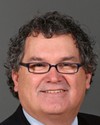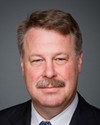Good morning, everybody.
My name is Basil MacLean. I'm the president of the Area 19 Snow Crab Fishermen's Association. I would like to take this time to thank you for giving me the opportunity to address the committee today.
We are located on the west coast of Cape Breton Island. It is a very small fishing zone, approximately 20 miles by 60 miles. Our zone borders the area 12 crab fishing zone. We are an inshore zone. Our vessels are under 45 feet. We operate under a very unique ITQ-style fishery, the only one of its kind in Canada. Our association is made up of strictly owner-operators. I, myself, have been an owner-operator in the fishery since 1992. Our association is the only association that represents area 19. No other associations represent our fishery other than us.
I'd like to talk a little bit about the southern gulf snow crab stock and the history. I know you're all aware of it by now, but according to page 9 of the March 2010 snow crab assessment for the southern gulf, the peak of the stock occurred in 1994 with a total of 154,000 metric tonnes of biomass. I know there are questions of how that number came to be, but that is the number that's in the document.
The fall of 2009 assessment shows a biomass of only 26,000 metric tonnes, which represents a decrease of 83%. That's unbelievable--83%. If you break down that decrease according to the fishing zones, area 19 represented only a 3.5% decrease.
I wonder today how this could have happened. How could the politicians, DFO management, and the fishermen ever have allowed such a huge decrease to happen to our stock? Well, in 1994 there was a huge push from politics to increase the number of participants in the crab fishery. At that time, the area 19 fishers were deeply concerned and wanted to have some control of our fishery. This is where the idea of co-management began in our fishery. Our fishermen spent countless hours and hundreds of thousands of dollars working with DFO, the community, and the politicians to draft a co-management agreement. In 1996, the first real co-management agreement in Canada was signed between DFO and area 19. We are still operating under a co-management agreement today, which is set to be renewed in 2013. The key objective of our co-management agreement was to base our fishery on three simple principles: one, use the best possible science; two, use the best possible fishing practices; and three, maximize the most socio-economic benefits for our communities.
Under this co-management framework we should have been able to avoid political pressure, but unfortunately we were not immune. Political pressure has negatively affected the entire southern gulf snow crab stock in two major ways.
The first one is the number of participants in the fishery. The increase of individuals to the crab fishery has also led to the number of traps now being used. From 1994 to present day, the number of traps in area 12 has increased from 18,000 to over 38,000, which represents a 106% increase. At the same time, we also increased our individuals in area 19, but we tried to minimize the number of traps being increased and we increased only 15%. We believe that a major problem with increasing the number of traps to the fishery is that you have increased the fishing mortality on the non-commercial stock, being the undersized, the females, and the soft shell. This creates a huge stress on the future stock.
The second way politics has affected it is with decisions made regarding the total allowable catch, or the TAC. These have been made without scientific evidence and against DFO management recommendations. A good example of this occurred in 2009. DFO science made a recommendation on page 22 of the CSAS working paper in February. They stated that a 17,000-metric-tonne TAC in area 12 would coincide with the reduced biomass in that zone. Politics determined a TAC of 20,900 tonnes. That is 24% above the scientific recommendation.
The big question is, who is to blame for the current state of the southern gulf snow crab stock? How did we get where we are today? Surely area 19 cannot be blamed for this. We have been managing our fishery on our own precautionary approach for many years.
What is our precautionary approach? We conducted our fishery over the last number of years on a trawl survey that is done just three weeks prior to the fishery. This short timeframe lowers the percentage of natural mortality from 25% to almost zero. It also lowers the chance of outward migration of our zone. As the biomass in area 19 has dropped, we have also dropped our TAC to coincide with the decrease in biomass. We have taken cuts; we have gone down every year.
Area 19 has provided funds to DFO for vessel and air patrols along our boundaries. We've done this to ensure that no outside poaching was done in our zone. We have provided funds for multiple trawls in the same year to make sure our stock was there. We wanted to know what was there. We did the extra trawls to make sure it was there.
We have provided funds for different scientific experiments. Just recently we did a multi-year larvae experiment with DFO science in Moncton, and we just finished doing a trap design study, which will help to leave the small crab, soft shells, and undersized on the bottom.
In area 19 we only start fishing after June 1. The reason is because of the two mating seasons in snow crab. The last season ends sometime in mid-May, according to science, so we wait until June 1. That way every adult male has a chance to mate. Right now, area 19 has currently started with pre-assessment for MSC certification, as we see this as the inevitable future for snow crab marketability. Our fishing practices and management schemes must be working for us, as our 2009 fall trawl has showed an almost 10% increase—a 10% increase—from fall 2008.
Under the new precautionary approach that has been introduced by DFO science for the southern gulf, area 19 has been lumped into the same category as other zones. We feel this is unfair and an injustice to our fishermen. I'm here today, before you, asking that area 19 be recognized for its uniqueness. Given the opportunity, area 19 can prove that we are good stewards to the fishery. A spring survey, a strict white-shell protocol, 100% downside monitoring, and the continuation of our co-management agreement will ensure the future of the stock and the future of the fishermen in area 19 for many generations to come.
I thank you for your time.




